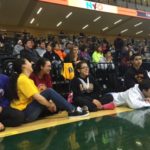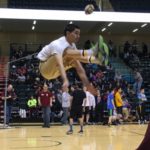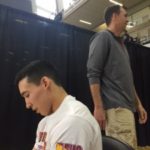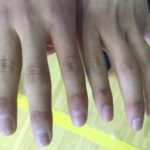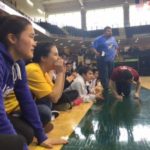
Mount Edgecumbe High School sent 15 students to the Native Youth Olympics in Anchorage April 21-23. The event draws Alaskan Native teens from around the state in three days of intense competition. KCAW was at the Alaska Airlines Center on the last day, cheering on the Braves from the sidelines.
Jeremy Roberts is from Quinhagak, near Bethel and he’s been training for the male seal hop event all year. “You can’t be slouchy. You have to be straight. And you have to hop: use your feet to help you go forward and just go until you can’t go anymore,” he explains.
Roberts flips over his fingers. On each knuckle is a rounded callus. They’re hard earned. He says, “I used to get my knuckles cut up but now they’re all scarred.” Jeremy is a senior, so this is his last year to compete. He’s gunning for first place.
Kneeling along the edge of the gym are fellow Edgecumbe students, wearing cardinal and gold colors, ready to cheer. Rachel Teter watches Jeremy from the sidelines. “He goes really fast too. There will be other guys that go pretty far. But he’s just way ahead of them in no time. And then it will take them a while to just catch up to catch up.
The seal hop event has its foundations in seal hunting, mimicking the animal’s movement on the ice and how the hunter sneaks to the edge to capture the seal. Rachel says hunters do more of an army crawl nowadays, but the point of the seal hop is the honor the strength and stamina needed for a subsistence lifestyle. “It’s a good way to incorporate the competitive side and the traditional side and the fun side into one event,” she tells KCAW.
The 2016 male seal hop event begins and pretty soon, it’s Jeremy’s turn. There are nervous teens on sides, shaking out their arms and legs and checking their own calluses. All eyes are on them.
NYO Official: Three, two, one…
Edgecumbe students: Go Jeremy!! Keep going, Jeremy!
And they’re off.
In a bent push up position, elbows at right angles, Jeremy pushes off those knuckles like springs.
Rachel Teter: Push yourself! Push yourself!
Rachel’s right. He’s fast and quickly gains the lead. Teammates plead with him to remember to breathe.
Edgecumbe students: Breathe! Breathe!
And then, Jeremy drops. He’s done. He hopped the full court, but after turning around didn’t make it back to half court. A Dillingham competitor got well beyond that, but Edgecumbe Coach Archie Young is nonetheless proud. “That’s the farthest he’s gone in the competition. Last year, he went 112 feet. So that’s a very good improvement.”
Jeremy’s distance today is 128″ 4.25 inches. He places third in the overall contest. Young is Edgecumbe’s PE teacher and has been training students for NYO for four years. Seal hop is his favorite event. “I love the grit of it and I love that it’s just how strong a mind and how far can I go,” Young said.
Pushing yourself, beyond what you think you can do, is at the core of the NYO Games and other games steeped in Alaskan Native traditions. Most teens are trying to back their personal records, not world records. And in a survey last year, 75 percent reported that NYO is an incentive to stay in school and get good grades.
Laura Ekada competes in Indian Stick Pull, which symbolizes grabbing a slippery fish out of the water. “To me it means I’m carrying on my tradition and I’m keeping things going. Because times are changing and things are getting lost. And I’m just so glad to be part of this,” Ekada said. She wants to go to med school one day.
Rachel Teter remembers the first time she competed in Indian Stick Pull. She was 12, at the World Eskimo-Indian Olympics in Fairbanks. And she was surprised standing before her competitor, each one holding the end of a wooden dowel, trying to wrestle it away from the other.
Rachel recalls, “She must have been 70 or something and she was like, ‘Wow! Youngest and the oldest. You’re just a baby.’ And I was like, ‘Uh, huh.’ And she was like, ‘Let’s see. New and old. Let’s see how this goes.’
They ended up tying and trading big hugs. Rachel says sportsmanship is a huge part of these competitions. You have to cheer as loudly for other teams as you do for your own.
